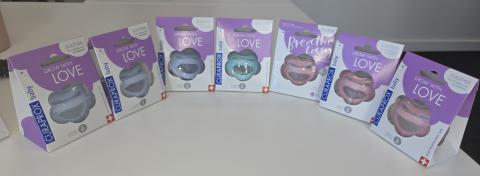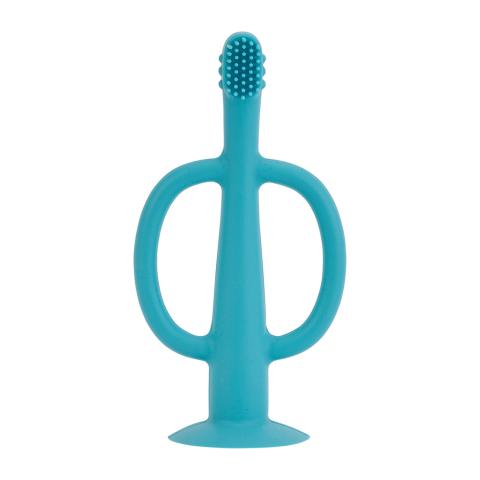On this page
About dummies and dummy chains
A dummy has a rubber or soft plastic teat, a hard plastic shield with holes and a ring or a handle to hold it easily. Babies suck on dummies for comfort.
Dummies are also called pacifiers or soothers.
A dummy chain is a pin, ribbon, string, cord, chain or any similar item that attaches the baby’s dummy to their clothing.
Risks and injuries from the product
Most baby dummies are safe. While injuries from dummies are rare, there are risks with using old dummies or dummies that don’t meet the mandatory standard.
Children under 3 years old are at risk of choking as they have not yet developed the reflex action to cough up objects that lodge in their throats.
Babies using unsafe dummies can choke:
- if dummy shields are too small and don’t have ventilation holes. A dummy that is too small can fit inside a baby’s mouth and block the airway
- when the teat detaches from the shields of old or poorly made dummies. It can get stuck in a child’s throat and cause suffocation.
Babies can also suffer choking or strangulation if:
- the cord or ribbon used to attach dummies wraps around their neck or hooks onto other objects
- part of the dummy chain or decorations break and are swallowed and get stuck in a child’s throat or airway.
Babies can get infections when:
- the teat of an old or poorly made dummy allows saliva, food and other substances with bacteria to enter inside it
- the dummy is not cleaned properly.
Babies using imitation dummies can be at risk of choking, strangulation and hanging.
Button batteries, if accessed and swallowed, can cause life threatening internal chemical burns.
Things to look for when buying the product
Babies can choke if their dummy is old or damaged. Some dummy chains may cause strangulation or choking.
For this reason, there’s a mandatory standard that suppliers and retailers must comply with.
Only buy and use dummies and dummy chains that comply with the baby dummies and dummy chains mandatory standard.

The mandatory standard excludes flashing imitation dummies.
These dummies look like baby dummies but have additional electronic components including button batteries so they light up.
Keep them out of reach of children. These are novelty items and dangerous for babies and young children.
Buying a dummy
- Check the dummy has a shield and ventilation holes. This helps prevent suffocation if the baby puts the whole dummy in their mouth.
- The dummy is sold with a safety warning notice. The warning notice comes with the packaging or is in a leaflet supplied with the dummy.
- It is sold in a clean condition and in a sealed pack.
- It is sold with instructions for using the dummy and hygienic care.
- The dummy must not have any printing on the sucking side of the shield or adhesive decals attached to any part of the dummy.
- Decorations, such as beads, charms and ribbons, must not detach from the dummy. This can result in a choking, inhalation or swallowing risk.
Buying a dummy chain
- The dummy chain isn’t longer than 22 cm.
- Parts can’t break, tear or separate from the dummy chain.
- The fastener on the chain used to attach it to a baby’s clothes is strong enough to withstand repeated use.
- There are no adhesive decals or labels on the dummy chain.
How to use the product safely
To keep your baby safe, make sure you:
- follow the product assembly instructions
- follow product guidelines for your baby’s age, size and development
- replace dummies according to the products instructions, especially if worn or damaged
- sterilise or wash dummies according to the product’s instructions
- check your baby’s dummy before every use by pulling gently on the teat and tugging on the handle or ring
- throw it away if you see holes, tears or bite marks
- never leave a dummy in direct sunlight or hot spots, such as the car. This can cause rubber to perish
- never leave a baby with a dummy in their mouth if they can’t remove it on their own
- never use ribbon or cord to attach dummies to children’s clothing, cots or prams. These ties can get caught and wrap around a child’s neck and cause strangulation.
Watch our video on dummy safety
You may want to use a dummy to soothe and settle your baby. However, dummies can be a choking and suffocation hazard if not used correctly.
This video covers tips for the safe use of dummies.
Video transcript
TEXT: Your first steps to a safe dummy
VISION: A woman is testing a dummy over a sink. With a press, a small tear is revealed.
TEXT: Step 1: If there's wear and tear, it's time for the spare
VISION: The woman grabs a spare dummy from the drawer, and snips off decorative beads with a pair of scissors.
TEXT: Step 2: Beware of beads
Step 3: For more safety tips visit productsafety.gov.au
ACCC Product Safety. Your first steps. productsafety.gov.au







